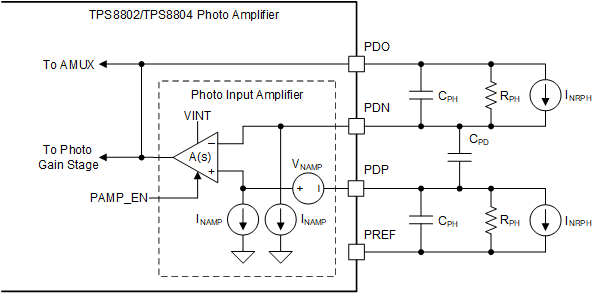SLVAEX3 October 2020 TPS8802 , TPS8804
3.2.1 Noise Sources
The noise generated by the photo input amplifier and gain resistors RPH generally exceed the noise generated by the photo gain stage, AMUX buffer, and photodiode. The photo amplifier schematics with noise sources modeled is displayed in Figure 3-4. The photo input amplifier is modeled with input voltage and current noises. Op-amp voltage noise is displayed as VNAMP and current noises are displayed as INAMP. The two amplifier current noises are assumed equal, as the op-amp has voltage feedback.
Thermal noise is a noise source that naturally occurs in resistors. Thermal noise is modeled as a voltage noise in series with the resistor or equivalently a current noise in parallel with the resistor. The thermal noise sources in the photo input amplifier stage are shown in Figure 3-4 as INRPH. Here, a current noise is used because the current-to-voltage amplifier transfer function is calculated in Equation 5. The thermal noise at 300 K is calculated in Equation 12.
 Figure 3-4 Photo Input Amplifier With Noise
Sources Modeled
Figure 3-4 Photo Input Amplifier With Noise
Sources Modeled